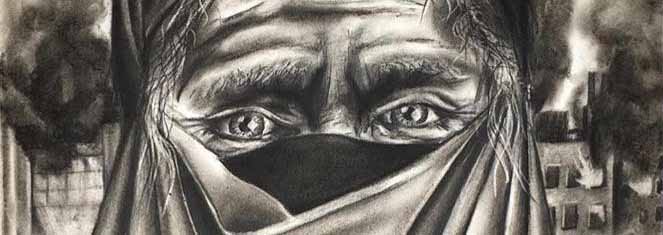With charcoal smeared down his right arm, David Foster completes the finishing touches of his masterpiece: the humble eyes of a scarved Syrian refugee.
“The background is just rubble and the burning, and a lot of these [refugee] women have very similar stories, coming from destroyed cities,” Foster says.
Like most artists who examine political messages through their art, Palo Alto High School junior Foster highlights a topic that needs exposure: Syrian refugee women.
Many people today, outraged by decisions made by our political leadership, turn to visual art to express their opinions. Photography is one of the strongest forms of expression, says Margo Wixsom, AP Studio Art 2D Design teacher.
The power of visual art
“Photographers are possibly the most influential artists today and will continue to be into the future because our world so deeply depends upon photography to illustrate, authenticate, advocate, administrate everything,” Wixsom says, adding that photography is one of the strongest platforms to advocate for issues because it illustrates messages in a digestible way.
“Our very understanding of politics is premised on photojournalism, I would say: the front page images of the [North Carolina] protests, documenting the genocides in the world, recording natural disasters that are consequences of climate change,” Wixsom says.
The immense power of photography, and visual art in general, is that everyone is able identify the message from the piece.
“[Visual] art is democratic. … People from different backgrounds and different education levels can all sympathize and understand [visual] art.”
– AP Studio Art 2D Design student Sophia Muys
Future of political art
The foci of political art have fluctuated throughout history, but similar topics tend to resurface, Wixsom says. This is because the focus of political art often describes problems that need to be addressed by the community. The consistency in morals causes certain topics to re-emerge, as they play an important role in society, regardless of the time period. Wixsom describes her inspiration for the project “Art as a Social Issue” as being based off this concept of re-emerging problems in society, more specifically attitude towards LGBT.
“Art was a response to an abusive individual who sought to destroy freedoms through cutting up books on LGBTQ, sex, women’s studies,” Wixsom says. “Sadly we are seeing a resurgence against LGBTQ … that is certainly a national tragedy and disheartening to me personally.”
However, accompanying the resurgence of these social issues is a movement of artists who take to technology to advocate for their opinions.
“Advocating for social issues will continue to expand with social media and new technologies, all of which heavily employ visual content,” Wixsom says.
Becoming a political artist
A good starting point for a rising political artist is to choose a topic to focus on based off specific instances where you experienced a serious issue, according to Muys.
“There was one occasion where a phtographer came to our school,” Muys says. “Me and my friend were really interested in his work, and went up to talk to him and ask him a few questions about his profession, and he said, ‘Oh. You girls don’t need to worry about this. If you just marry someone rich, you won’t have to do any work or anything like that. It shifted my artistic perspectives in the direction of activism.”
Once an area of interest is identified, artists often research to create a fully developed idea, Foster says.
After refining the idea, one should move to execution of a piece.
“A well-executed piece is easier for audiences to understand and take a message from,” Foster says.
Although it should be clear as to what is being portrayed, the message behind the piece is still up to individual interpretation.
Wixsom is trying to get people to normalize thinking about art in a more meaningful way through her project “Art as a Social Issue”. She is familiarizing her students with using art mediums as a means of expressing themselves politically. Wixsom not only helps improve students’ art skills, but also making them more comfortable using their art to display a message.
The “Art as a Social Issue” project gave Muys a platform to express her topic of interest: feminism. She plans to highlight people’s stories and create powerful pieces to empower young women, which in turn forces the message into public’s eye.
“It’s to make people think,” says Foster. “There’s a fine line. Even if there is a politically motivated piece that has a point that you may not agree with, it makes you think.” v


